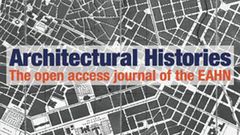The jury, formed by Mark Crinson, Kenny Cupers and Helena Mattsson granted Sheila Crane for ‘Algerian Socialism and the Architecture of Autogestion’. In their report, the jury highlights the nuanced and carefully argued discussion of the theory of Abderrahman Bouchama and its impact on the work of a number of Algerian architects, affirming that ‘this is a brilliant analysis of a particular aspect of architecture in post-revolutionary Algeria, one in which the government policy of autogestion (self-management) was transferred and re-imagined in architectural terms’.
In addition, the jury made two honourable mentions:
- One for runner-up to Andreas W. Putz for ‘Housing Paul and Paula: Building Repair and Urban Renewal in the German Democratic Republic’
Putz’s article considerably advances our understanding of architecture and reconstruction in post-war East Germany. Focussing on the repair of buildings, and the re-direction of the construction industry and its technologies to this end, Putz shows how through these techniques architects not only advanced urban renewal but also how they brought historic forms back into circulation in new economic circumstances. The article adroitly juggles fascinating details and many relevant contexts, helping us understand better how repair and re-appropriation were also a part of making the socialist world. - And one for best article by a young scholar to Rixt Woudstra for ‘Exhibiting Reform: MoMA and the Display of Public Housing (1932-1939)’
Still a PhD student at the time of the publication of this article, Rixt Woudstra has produced a substantial new account of MoMA’s commitment to housing reform in the New Deal era of the 1930s. We can now understand much better how this social project of architecture, supposedly marginalised by MoMA’s International Style interests, was interwoven with formal interests, even as it was subsequently treated as separate. Not only was it closely aligned with the policies of government and housing organisations, but it also, Woudstra argues, continued to offer a different set of architectural values, if shorn of their implications for architecture more generally.
The complete jury report can be read here.
Architectural Histories is the international, open access, blind peer-reviewed scholarly journal of the EAHN (European Architectural History Network) that creates a space where historically grounded research into all aspects of architecture and the built environment can be made public, consulted, and discussed. The journal is open to historical, historiographic, theoretical, and critical contributions that engage with architecture and the built environment from a historical perspective.
